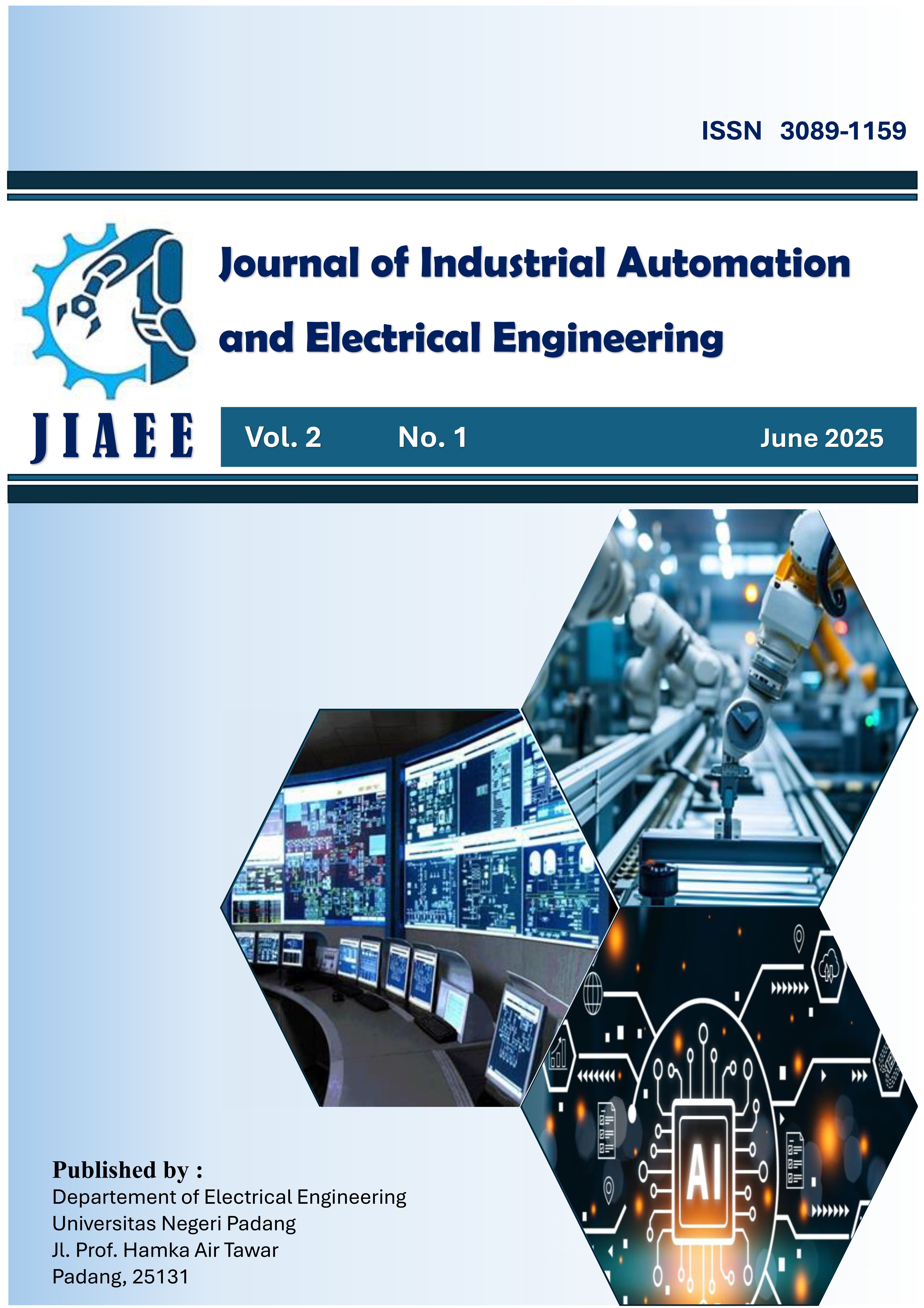Enhancing Electricity Production in Photovoltaic Systems Using a Double-Axis Solar Tracker
DOI:
https://doi.org/10.24036/j4jk5m10Keywords:
Double axis solar tracker, Solar Energy, Energy Efficiency, Renewable EnergyAbstract
The global energy crisis, still heavily reliant on fossil fuels, drives the need for innovations in renewable energy utilization, particularly solar energy. Indonesia, with abundant solar energy potential, has a significant opportunity to enhance solar energy usage through solar tracking technology. This study aims to design and test an Arduino-based double axis solar tracker system that improves solar energy absorption efficiency. The system uses an Arduino Mega 2560 as the main controller, equipped with Light Dependent Resistor (LDR) sensors and other supporting sensors to optimize the solar panel’s position. Testing was conducted under three weather conditions: sunny, partly cloudy, and overcast, to compare the performance of the double axis system with single axis and fixed panels. The results indicate that the double axis solar tracker system produced the highest power output under all weather conditions, especially on sunny days, with an increase in power efficiency of up to 30-35% compared to fixed panels. This technology provides an efficient and economical solution for Indonesia to maximize solar energy utilization, supporting national renewable energy targets.
Downloads
References
[1] G. Gentile and J. Gupta, “Orchestrating the narrative: The role of fossil fuel companies in delaying the energy transition,” Renew. Sustain. Energy Rev., vol. 212, no. December 2024, p. 115359, 2025, doi: 10.1016/j.rser.2025.115359.
[2] T. Harlan and J. Baka, “Stacked energyscapes: Conceptualizing fossil fuel and renewable energy entanglements in low-carbon transitions,” Energy Res. Soc. Sci., vol. 115, no. June, p. 103648, 2024, doi: 10.1016/j.erss.2024.103648.
[3] A. Sharif, U. Bashir, S. Mehmood, C. W. H. Cheong, and M. F. Bashir, “Exploring the impact of green technology, renewable energy and globalization towards environmental sustainability in the top ecological impacted countries,” Geosci. Front., vol. 15, no. 6, p. 101895, 2024, doi: 10.1016/j.gsf.2024.101895.
[4] A. Sulaiman & M. Nasir, “ Solar energy potential and challenges in Indonesia: A review,” Journal of Renewable Energy, vol. 9, no. 4, p. 112-123, 2020.
[5] E. Mustafa, M. Yuhendri, J. Sardi, and D. T. Yanto, “Kendali dan Monitoring Pembangkit Listrik Tenaga Surya Stand Alone Berbasis Human Machine Interface,” JTEIN J. Tek. Elektro Indones., vol. 4, no. 1, pp. 179–189, 2023.
[6] D. Kusuma, “ Current status and future projections of solar energy in Indonesia,” Energy Policy Journal, vol. 58, p. 343-352, 2021..
[7] R. Fernandes and M. Yuhendri, “Implementasi Solar Tracker Tanpa Sensor pada Panel Surya,” JTEV (Jurnal Tek. Elektro dan Vokasional), vol. 6, no. 2, pp. 337–343, 2020.
[8] H. Mousazadeh., A. Keyhani, A. Javadi., H. Mobli., K. Abrinia, & A. Sharifi, ”A review of principles and sun-tracking methods for maximizing solar system output,” Renewable and Sustainable Energy Reviews, vol.13, no. 8, 1800-1818, 2018.
[9] A. Musafa, A. Priyadi, V. Lystianingrum and M. H. Purnomo, "Solar Tracker-Rainfall Collector on Small-Scale Hybrid Photovoltaic-Pumped Hydro Systems to Increase Stored Energy," in IEEE Access, vol. 12, pp. 184788-184802, 2024, doi: 10.1109/ACCESS.2024.3513978.
[10] S. L. Jurj and R. Rotar, "Increasing the Solar Reliability Factor of a Dual-Axis Solar Tracker Using an Improved Online Built-In Self-Test Architecture," in IEEE Access, vol. 12, pp. 37715-37730, 2024, doi: 10.1109/ACCESS.2024.3375333.
[11] P. Rani, O. Singh, and S. Pandey, “An analysis on Arduino based single axis solar tracker,” in Proc. 5th IEEE Uttar Pradesh Sect. Int. Conf. Electr., Electron. Comput. Eng. (UPCON), Nov. 2018, pp. 1–5, doi: 10.1109/UPCON.2018.8596874.
[12] T. Kaur, S. Mahajan, S. Verma, and J. Gambhir, “Arduino based low cost active dual axis solar tracker,” in Proc. IEEE 1st Int. Conf. Power Electron., Intell. Control Energy Syst. (ICPEICES), Jul. 2016, pp. 1–5, doi: 10.1109/ICPEICES.2016.7853398.
[13] Y. Bekakra, L. Zellouma, and H. Serhoud, “Design and implementation of a solar tracker system with dual axis for photovoltaic panels in El Oued region of Algeria,” in Proc. 1st Int. Conf. Sustain. Renew. Energy Syst. Appl. (ICSRESA), Dec. 2019, pp. 1–6, doi: 10.1109/ICSRESA49121.2019.9182599.
[14] A. K. Suria and R. M. Idris, “Dual-axis solar tracker based on predictive control algorithms,” in Proc. IEEE Conf. Energy Convers. (CENCON), Oct. 2015, pp. 238–243, doi: 10.1109/CENCON.2015.7409546.
[15] A. Y. Pratama, A. Fauzy, and H. Effendi, “Performance enhancement of solar panel using dual axis solar tracker,” in Proc. Int. Conf. Electr. Eng. Informat. (ICEEI), Jul. 2019, pp. 444–447, doi: 10.1109/ICEEI47359.2019.8988902.
[16] R. Xu, X. Ji, C. Liu, J. Hou, Z. Cao and H. Qian, "Design and Control of a Wave-Driven Solar Tracker," in IEEE Transactions on Automation Science and Engineering, vol. 20, no. 2, pp. 1007-1019, April 2023, doi: 10.1109/TASE.2022.3177353.
[17] H. Fathabadi, “Novel online sensorless dual-axis sun tracker,” IEEE/ASME Trans. Mechatronics, vol. 22, no. 1, pp. 321–328, Feb. 2017







